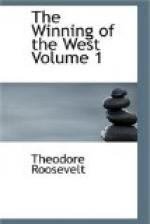Thus the spring of 1774 opened with every thing ripe for an explosion. The Virginian borderers were fearfully exasperated, and ready to take vengeance upon any Indians, whether peaceful or hostile; while the Shawnees and Mingos, on their side, were arrogant and overbearing, and yet alarmed at the continual advance of the whites. The headstrong rashness of Conolly, who was acting as Lord Dunmore’s lieutenant on the border, and who was equally willing to plunge into a war with Pennsylvania or the Shawnees, served as a firebrand to ignite this mass of tinder. The borderers were anxious for a war; and Lord Dunmore was not inclined to baulk them. He was ambitious of glory, and probably thought that in the midst of the growing difficulties between the mother country and the colonies, it would be good policy to distract the Virginians’ minds by an Indian war, which, if he conducted it to a successful conclusion, might strengthen his own position.[16]
There were on the border at the moment three or four men whose names are so intimately bound up with the history of this war, that they deserve a brief mention. One was Michael Cresap, a Maryland frontiersman, who had come to the banks of the Ohio with the purpose of making a home for his family.[17] He was of the regular pioneer type; a good woodsman, sturdy and brave, a fearless fighter, devoted to his friends and his country; but also, when his blood was heated, and his savage instincts fairly roused, inclined to regard any red man, whether hostile or friendly, as a being who should be slain on sight. Nor did he condemn the brutal deeds done by others on innocent Indians.
The next was a man named Greathouse, of whom it is enough to know that, together with certain other men whose names have for the most part, by a merciful chance, been forgotten,[18] he did a deed such as could only be committed by inhuman and cowardly scoundrels.
The other two actors in this tragedy were both Indians, and were both men of much higher stamp. One was Cornstalk, the Shawnee chief; a far-sighted seer, gloomily conscious of the impending ruin of his race, a great orator, a mighty warrior, a man who knew the value of his word and prized his honor, and who fronted death with quiet, disdainful heroism; and yet a fierce, cruel, and treacherous savage to those with whom he was at enmity, a killer of women and children, whom we first hear of, in Pontiac’s war, as joining in the massacre of unarmed and peaceful settlers who




